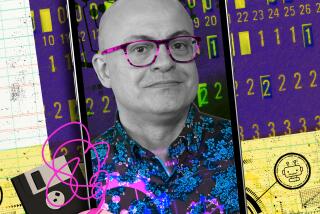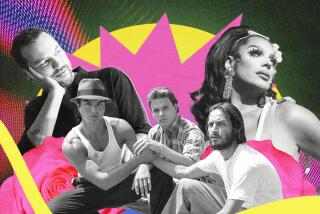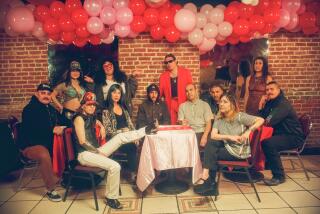Backdraft
Does anyone seriously believe that Los Angeles will be around in 500 years? Or will its splendor and glory be brief, before going the way of the Maya ruins in the forested oblivion of Central America? That’s an unexpected question provoked by “The Tattooed Soldier,” Hector Tobar’s suspenseful novel of Guatemalan immigrants surviving in forgotten subway tunnels and on overgrown hillsides in downtown Los Angeles.
The 7th century rulers of Tikal in today’s Guatemala, a capital of the late Maya empire, must have felt as secure as the present leaders of global cities such as L.A. But today the towers of Tikal are left to tourists and archeologists in Guatemala’s forests. The Maya city-states collapsed for uncertain reasons, perhaps through ecological stress, unsolvable social conflict or royal arrogance. In the Maya view, human fate is repeated cycles of birth and decline, conquest and revival.
This fine novel is about fate and consequences. Using flashbacks, the author creates a steadily escalating confrontation between two Guatemalans who meet in Los Angeles at a dramatic moment of life or death. The hero is Antonio Antonio, once a student in Guatemala City and now homeless and unemployed in Los Angeles. The antagonist is retired Sgt. Guillermo Longaria, a soldier who killed Antonio’s wife and child in a death-squad operation in Guatemala and now spends his days in an apartment on Bonnie Brae Street, studying mind control and playing chess.
The arcs of their personal fates are rooted in historical fate. In 1954, the CIA overthrew the national government of Jacobo Arbenz. There followed three decades of repression, climaxing in a near holocaust of indigenous people in which 200,000 died and 1 million fled in the 1980s. Tobar’s novel follows the violence as it spills over into the immigrant communities of Los Angeles, represented in the lives of Bernal and Longaria, the tattooed soldier. The showdown between the two men coincides with the 1992 Los Angeles riots, known as the quemazones (“great burning”) to the immigrants and called the “municipal day of vendettas” by the author.
Tobar, a Los Angeles Times reporter who came from Guatemala as a small child, has a fine storyteller’s instinct. His portraits of Bernal and Longaria are deeply empathetic, as are the sketches of Antonio’s wife, Elena, and his homeless Mexican compadre, Jose Juan Grijalva. Behind Antonio’s dirty, disheveled, slumped appearance is a former college student who came from Guatemala City during the repression and disappearances of the 1980s. In those days, wooing Elena, Antonio was lanky, bespectacled, forgetful, a fan of Federico Garcia Lorca and Russian novels. When he met his future wife, Antonio gave her a book on Maya languages that cost him his last quetzal. Elena was an activist who drew him into student protests and demonstrations on behalf of garbage workers.
When Elena and their baby are murdered, Antonio is away at work. He is warned by terrified witnesses to leave town immediately. As he boards a bus for Los Angeles, the killer is pointed out. It is Longaria, sitting on a park bench, eating an ice cream cone. On his left arm is an unmistakable tattoo of a jaguar, jaws open, the sign of Longaria’s army unit. Antonio leaves but is pierced by survivor’s guilt and his inability to take revenge.
In Los Angeles, Antonio takes work as a busboy and finds that “Los Angeles made you less than you were back home.” One employer, a Polish Jew named Mr. Finkel, is kind to Antonio, perhaps because he recognizes the “concealed trauma” behind Antonio’s dour mask. Elena has become a “living scream” in his brain, and the rest of Los Angeles ignores him as an invisible busboy, avoiding him altogether when he is evicted and becomes homeless.
Antonio lies awake at night staring at the downtown skyscrapers, whose lights are like a thousand glass eyes watching over him, each with a Salvadoran or Guatemalan janitor inside. He discovers urban ruins in Los Angeles that remind him of Maya ones back home. Where earlier visitors sought their fortune, all that remain are forgotten city street names engraved in the dirt (“Diamond Street, Emerald Street, 1919, Inspected”) or the long-abandoned tunnel of the Pacific Electric Rail Co., the concrete “temple” in which the homeless take shelter.
Longaria, for his part, is tormented by “living screams” as well: those of the children and other innocent people he has killed. He survives by being obsessive about order, cleanliness and turning his mind into a machine. He works as a security guard in El Pulgarcito Express mail house because “his stare always chased the complainers away.” He likes the Salvadoran girlfriend he met at a Taco Bell “because she talked endlessly, even when he wasn’t listening.” When they make love on Saturday afternoons, Longaria frets about whether his neighbors in the Westlake Arms have heard their animal noises and then wraps the used condom in three feet of toilet paper.
Longaria was forcibly drafted into the Guatemalan military as a teenager while he was in a theater watching the Hollywood-based fantasy “E.T.” He was trained at Ft. Bragg, N.C., where everything from uniforms to front lawns was neat beyond belief. “He thought that the new Guatemala would be like Ft. Bragg.” Instead the “infection” of subversive activity follows him from Guatemala to L.A. Human rights activists from Salvador and Guatemala are holding rallies in MacArthur Park, disrupting his chess matches. The children whose parents the death squads assassinated are reincarnated as aggressive cholos from the Bixel 13 gang, who mark off the stoop below his window as their territory. Once the 1992 riots begin, Longaria realizes that the war in Guatemala has followed him to Los Angeles. He rushes to buy a weapon.
There are zany, humorous sketches woven into this tale of fate. The “mayor” of Antonio’s homeless camp relaxes on his hillside couch, watching and counting traffic accidents where the downtown freeways merge. Antonio’s friend Jose Juan goes off as a day laborer and returns to announce his immigrant good fortune: “I am living in Beverly Hills!” He has moved in with a nanny in the guest house of a mansion whose owners are “in Europe at something called a ‘film festival.’ ” Thus does Tobar portray the surreal light at the end of the immigrant tunnel.
As the author moves his characters toward the climax with the skill of a chess master, he also includes deeper commentaries on urban pathologies. When Antonio looks into the eyes of a street friend, a permanent victim of an industrial accident, he sees “brown irises swimming in a buttermilk sea, the eyes of a lifelong alcoholic,” he can see behind the gaze “some act of violence, repeated and repeated.” Antonio’s suffering unlocks an empathy with the permanently lonely and witnesses to catastrophe. “Antonio could almost spot them across a crowded room.”
“The Tattooed Soldier” is especially remarkable for the invisible world Tobar has so skillfully illuminated. Who realizes that there are 5,000 dispossessed Kanjobal-speaking Mayans in Pico-Union and South-Central who live, in Tobar’s description, in a canyon of brick tenements where not a single shaft of their corn can grow? Or that there are some 200,000 Guatemalans in L.A. County, the largest percentage of them refugees still seeking asylum from U.S.-backed wars in Central America? While an emerging number are professionals, along with their Salvadoran neighbors, they mostly labor in downtown garment sweatshops or as maids and gardeners on the Westside. Between 1994 to 1996, the households with incomes under $20,000 rose from 2.6 million to 3 million in L.A. County.
Like Antonio, they are invisible to the outside world, living just footsteps below the gleaming towers of the Arco and Wells Fargo centers and the Mark Taper Forum. Go west on 1st to Beverly Boulevard, 60 seconds from downtown, and you are in Central America, amid blocks of giros y encomiendas like the Pulgarcito Express, lavandarias, pupuserias, farmacias. Turn left on Bonnie Brae Street and you enter the world of “The Tattooed Soldier” (including a new MTA tunnel not very far from the abandoned Pacific Electric one). On 6th and Bonnie Brae is the vacant site of the Californian Hotel, burned down by homeless people trying to keep warm. In “The Tattooed Soldier,” it is a neighborhood seldom visited by most Angelenos: “We wonder, ‘Where are the Americans?’ ” a Maya immigrant recently told a reporter.
Here are the neighborhoods where the refugee children of the Central American wars joined the 18th Street gang and formed the Mara Salvatrucha gang in the early 1980s. Ask these children, and many will tell you that their parents in El Salvador or Guatemala were beaten or disappeared; a surprising number saw them shot.
Now the wind of violence from Central America is a back draft. On the “municipal day of vendettas” in 1992, the 18th Streeters and Mara Salvatrucha were joined by a respectable cross-section of immigrants in an urban meltdown that Tobar captures well: “Housekeepers, garment workers, bus boys. Mexican, Honduran, Costa Rican, Nicaraguan. And of course, his countrymen, the Guatemaltecos. It was a day without submissiveness, a day without coffee to pour or strangers’ babies to feed or the whir of sewing machines in a factory. . . . A day when all the pretty objects in the store windows would mock them no longer.” His murdered wife, Elena, Antonio thinks, “would have loved to see the throngs of nannies taking over the streets of an American city, like the garbage workers they had joined in Guatemala all those years ago.” But then, Tobar notes, once the hunger for vendettas is satisfied, the passive and obedient manner of the immigrants returns. They clean the streets, just as they clean the homes of the rich. The brazen spirit sinks like cooling lava beneath the quiet volcano of the city.
Tobar’s tale is fictional and factual. There were death-squad kidnappings and violence in Los Angeles in 1987, when Salvadoran refugee Yanira Corea was abducted and raped, another woman was kidnapped for four hours and 30 community, religious and political leaders received threatening letters. Last year, a Guatemalan refugee’s wife, son and brother-in-law were tied up and killed, “death-squad style,” according to local Guatemalan social workers.
Nor can these refugees go home safely. Students like Antonio and Elena were killed by troops on the San Carlos campus as recently as 1995, and in April, Bishop Juan Gerardi was bludgeoned to death after issuing a report on human rights violations. His assassins identified themselves as “jaguars,” just like the fictional Longaria.
The U.S. government has bloody hands on this wheel of fate. It is stalemated in a war on youth gangs, while doing little about jobs or schools in the barrio. It is deporting many Guatemalans who fear for their lives (6,000 illegal immigrants officially “removed” since the beginning of 1997), while it admits complicity in the very repression that drove so many to Los Angeles. In 1995, President Clinton ordered the U.S. Intelligence Oversight Board to examine CIA involvement in two murders. In June 1996, the board concluded that the CIA had planned or participated in “extrajudicial” killings, torture and abductions in Guatemala. Worse, the oversight board concluded that “U.S. national interests, with respect to Guatemala and elsewhere, can in some cases justify relationships with ‘assets’ and institutions with sordid or even criminal backgrounds.”
In the face of such violence, you are left after reading “The Tattooed Soldier” wondering whether the 5,000-year-old Maya repetitive calendar (“the Long Count”) is more authentic than arrogant Western confidence in linear progress. Will Los Angeles stay a “global city” if its rulers occupy skyscraper suites in air-conditioned indifference to Mayans working in sweatshops? Will the war against indigenous people in the Americas ever really end? The prophetic Maya spiritual book the “Popul Vuh” pleads that “none be left behind the rest.” Without that vision guiding the long-term, who is to say that Los Angeles will avoid the fate of empires long forgotten?
More to Read
Sign up for our Book Club newsletter
Get the latest news, events and more from the Los Angeles Times Book Club, and help us get L.A. reading and talking.
You may occasionally receive promotional content from the Los Angeles Times.









